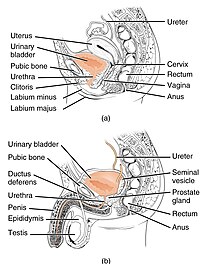
Does Urinary Retention Discriminate Multiple System Atrophy From Parkinson's Disease?
Sign Up to like & getrecommendations! Published in 2020 at "Movement Disorders"
DOI: 10.1002/mds.28049
Abstract: Although we agree with Chaudhuri and colleagues that the prevalence of dyskinesia is less than in the past, we again emphasize that this may come at the expense of undertreating our patients. A highly effective,… read more here.
Keywords: urinary retention; system atrophy; disease; retention discriminate ... See more keywords

Urinary retention and catheter use among U.S. female Medicare beneficiaries: Prevalence and risk factors
Sign Up to like & getrecommendations! Published in 2017 at "Neurourology and Urodynamics"
DOI: 10.1002/nau.23248
Abstract: To identify the prevalence of and risk factors for urinary retention and catheterization among female Medicare beneficiaries. read more here.
Keywords: prevalence risk; urinary retention; among female; risk factors ... See more keywords

Urinary retention after AdVance™ Sling: A multi‐institutional retrospective study
Sign Up to like & getrecommendations! Published in 2020 at "Neurourology and Urodynamics"
DOI: 10.1002/nau.24591
Abstract: To identify risk factors for urinary retention following AdVance™ Sling placement using preoperative urodynamic studies to evaluate bladder contractility. read more here.
Keywords: sling multi; retention advance; urinary retention; advance sling ... See more keywords

Are we underestimating urinary retention following intravesical onabotulinumtoxinA in women with overactive bladder and a history of prior pelvic surgery?
Sign Up to like & getrecommendations! Published in 2022 at "Neurourology and Urodynamics"
DOI: 10.1002/nau.25054
Abstract: This study's purpose is to review the rates of urinary retention requiring intermittent catheterization (IC) post intravesical OnabotulinumtoxinA (BTN/A) injection for idiopathic overactive bladder from a single practicing specialist urological surgeon. read more here.
Keywords: overactive bladder; intravesical onabotulinumtoxina; underestimating urinary; urinary retention ... See more keywords

Predictors of delayed postoperative urinary retention after female pelvic reconstructive surgery
Sign Up to like & getrecommendations! Published in 2020 at "International Urogynecology Journal"
DOI: 10.1007/s00192-020-04372-8
Abstract: Risk factors can be used to determine what patients will develop delayed postoperative urinary retention after female pelvic reconstructive surgery. A case-control study was performed including all female pelvic reconstructive surgeries necessitating a voiding trial.… read more here.
Keywords: surgery; delayed postoperative; postoperative urinary; urinary retention ... See more keywords

Do urodynamics predict urinary retention after sling placement in the complex patient: the value of reproducing symptoms on urodynamics
Sign Up to like & getrecommendations! Published in 2020 at "International Urogynecology Journal"
DOI: 10.1007/s00192-020-04623-8
Abstract: Introduction and hypothesis To examine urinary retention (UR) after female urethral sling placement in patients with or without detrusor underactivity (DU) or Valsalva voiding whose urodynamics (UDS) accurately reproduced voiding symptoms to determine whether the… read more here.
Keywords: sling placement; urinary retention; valsalva voiding; urethral sling ... See more keywords

Post-operative urinary retention after lower extremity arthroplasty and the peri-operative role of selective alpha-1 adrenergic blocking agents in adult male patients: a propensity-matched retrospective cohort study
Sign Up to like & getrecommendations! Published in 2019 at "International Orthopaedics"
DOI: 10.1007/s00264-019-04420-z
Abstract: Purpose The purpose of this study was to determine whether male patients taking pre-operative selective alpha-1 adrenergic blocking agents have a lower likelihood of developing post-operative urinary retention (POUR) and a shorter length of hospitalization… read more here.
Keywords: lower extremity; selective alpha; urinary retention; extremity arthroplasty ... See more keywords

Palliative Prostate Artery Embolization for Prostate Cancer: A Case Series
Sign Up to like & getrecommendations! Published in 2019 at "CardioVascular and Interventional Radiology"
DOI: 10.1007/s00270-019-02227-4
Abstract: IntroductionProstate artery embolization (PAE) is recognized as a treatment for lower urinary tract symptoms (LUTS) in men with benign prostatic hyperplasia. LUTS and urinary retention are common in men with prostate cancer (PCa). The purpose… read more here.
Keywords: artery embolization; urinary retention; prostate cancer; embolization ... See more keywords

The use of tamsulosin to prevent postoperative urinary retention in laparoscopic inguinal hernia repair: a randomized double-blind placebo-controlled study
Sign Up to like & getrecommendations! Published in 2020 at "Surgical Endoscopy"
DOI: 10.1007/s00464-020-08050-0
Abstract: The rate of postoperative urinary retention (POUR) in laparoscopic inguinal hernia repairs is 1–22%. POUR may cause patient anxiety, discomfort, and increased hospital costs. Currently there is no standard prophylaxis for POUR. Preoperative administration of… read more here.
Keywords: postoperative urinary; urinary retention; study; pour ... See more keywords

The efficacy of green light laser prostatectomy in the management of urinary retention due to prostate hyperplasia
Sign Up to like & getrecommendations! Published in 2019 at "Lasers in Medical Science"
DOI: 10.1007/s10103-018-02712-1
Abstract: To evaluate the efficacy and safety of 120 W potassium titanyl phosphate (KTP) in the treatment of urinary retention (UR) due to benign prostate hyperplasia in high-risk patients. Forty-six male patients with mean age of 73.78 ± 9.82 years… read more here.
Keywords: prostate; prostate hyperplasia; urinary retention; green light ... See more keywords

Short term catheter management options for urinary retention following pelvic surgery: a cost analysis.
Sign Up to like & getrecommendations! Published in 2021 at "American journal of obstetrics and gynecology"
DOI: 10.1016/j.ajog.2021.07.025
Abstract: BACKGROUND Several studies have compared short term catheterization approaches and have demonstrated no difference in patient satisfaction, but none have evaluated their costs. OBJECTIVE To evaluate the costs of three pathways for short term catheter… read more here.
Keywords: office; catheter; urinary retention; management ... See more keywords